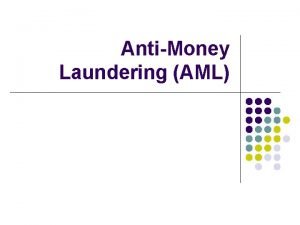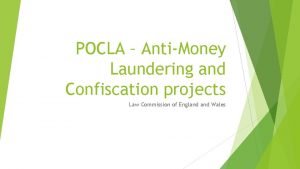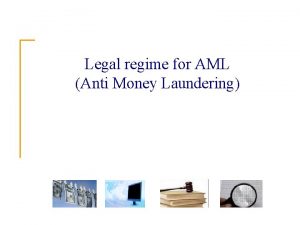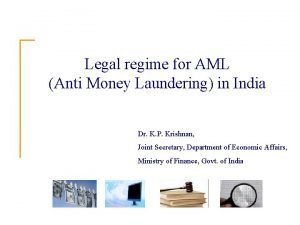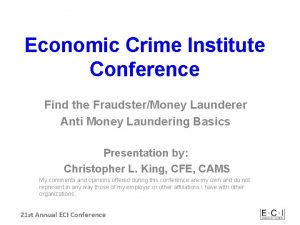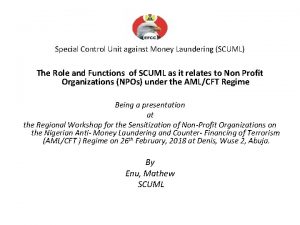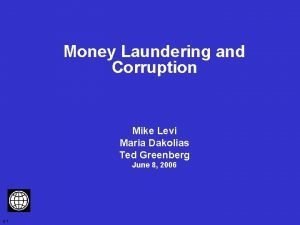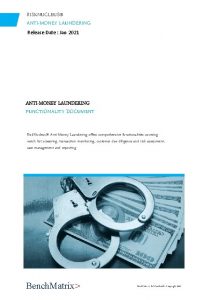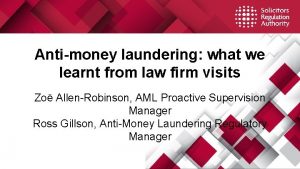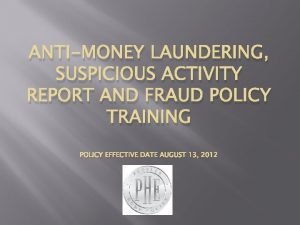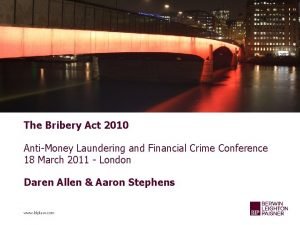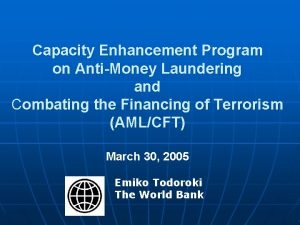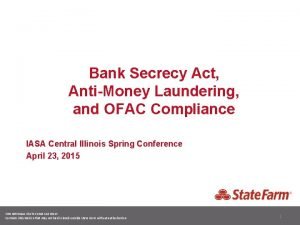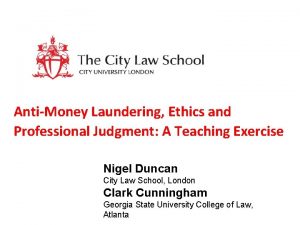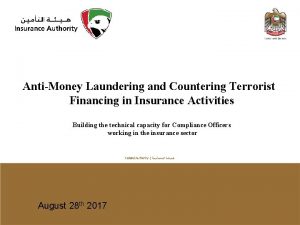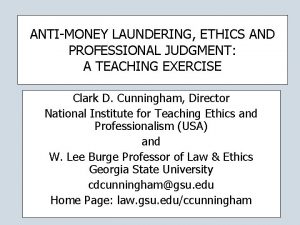POCLA AntiMoney Laundering and Confiscation projects Law Commission















- Slides: 15

POCLA – Anti-Money Laundering and Confiscation projects Law Commission of England Wales

Overview – AML Home Office reference Terms of reference – improving efficiency of the consent regime. Project started in February and we are due to publish our final report at the end of 2018. Timeline CP publication – 6 th July AML symposium – 6 th July Consultation period – until early September Analysis of consultation responses and final report. Publication of final report December.

Money Laundering The current law is provided in Part 7 of Proceeds of Crime Act 2002. Supplemented by the 4 MLD and Money laundering, terrorist financing and transfer of funds (information on the payer) regulations 2017. Money laundering offences Penalties Tipping offences Information sharing Regulated businesses and professionals – Supervisory authorities and OPBAS

Disclosures under Part 7 of POCA The two types of disclosures that are required under POCA: required disclosure and authorised disclosure. SARs High quality SARs are a vital source of intelligence. Burden on the reporters High volume of SARs – most of which come from the banking sector

Terrorism financing Part 2 of the Terrorism Act 2002 – parallel regime. Disclosure obligations where there is a suspicion of terrorist property under section 19 and 21 A of the Terrorism Act Terrorism financing offences (section 15 of the TA 2000) Exemptions to the terrorism financing acts – authorised disclosure Tipping offences for individuals in the regulated sector.

Issues within the consent regime “All crimes for all times” Low threshold for criminality. Low threshold for reporting. The authorised disclosure exemption. Broad definition of criminal property (s 340 POCA). Financial loss for those who are the subject of a disclosure.

All crimes approach Should technical breaches be included within the reporting requirements? If not should they be excluded by definition of the predicate offence or by reasonable excuse? Serious crimes vs all crimes

The meaning of suspicion Ordinary meaning of suspicion – there is no definition in POCA Hierarchy of fault – Knowledge, blind-eye knowledge, belief, reasonable grounds for suspicion and suspicion. Reasonable grounds to suspect – Saik – mixed test – subjective suspicion supported by objective grounds. Suspicion in a investigative context Suspicion tests in the proceeds of crime context.

The application of the concept of suspicion in the context of money laundering offences – R v Da Silva – “a possibility, which is more than fanciful, that the relevant facts exist. ” – Applied by Co. A in K v National Westminster Bank. The court in Da Silva did not articulate a standard of suspicion based on strength or degree. This has the effect that reports are being made where this is just an inkling that the property is dubious. Unusual vs suspicion. R v Saik – Lord Hope concluded that it is a mixed test. The benefit of a mixed test is that it provides an additional layer of protection. There is no consistent interpretation of suspicion across the sector-led guidance documents.

The application of the test of suspicion in the context of the disclosure offences Disclosure offence sections 330, 331 and 332 know, suspect, reasonable grounds to know or reasonable grounds to suspect. If a Saik interpretation was taken it would make the term suspicion redundant as it would be subsumed within “reasonable grounds to suspect”. Is “reasonable grounds to suspect” an objective test in this context?

The case for reforming the suspicion threshold Should suspicion be defined Would guidance improve the application of suspicion by the reporting sector? Would a prescribed form improve the application of suspicion? Should an alternative threshold be applied ‘reasonable grounds to suspect’ Amending section 330, 331 and 332 and the defence under sections 327, 328 and 329. This approach should be FATF compliant based on Canada’s application of a similar test and their compliance with FATF requirements

Confiscation timeline Project due to commence in September 2018 Stakeholder events. Due to report in Autumn 2020.

Confiscation Terms of Reference The review will aim to improve the process by which confiscation orders are made, ensure the fairness of the confiscation regime, and optimise the enforcement of confiscation orders. The review will analyse and address the most pressing problems with the law on confiscation. The review will also explore and assess a range of solutions to these problems. It will consider alternatives to the current value-based regime, options for a specialist forum for confiscation proceedings, and new ways of preventing the dissipation of assets. The review will also aim to simplify, clarify and modernise the law on confiscation. The Law Commission will produce a report making both recommendations for the amendment of the current legislative regime and recommendations for the creation of a new confiscation regime through legislation. The report will also consider non-legislative avenues for reform.

Confiscation Problems Complexity; Unrealistic confiscation orders: the legislative assumptions and hidden assets; The determination of third-party claims; Sanctions and incentives to satisfy confiscation orders are ineffective; Enforcement.

Confiscation Ideas for reform: Powers of restraint could be reformed to prevent the dissipation of assets; comparative research on this would be beneficial; The law on confiscation could be simplified and streamlined; issues addressed by inconsistent or unclear case law could be resolved in legislation; Courts hearing confiscation cases could be specialised; a confiscation court could be created, or ticketed judges introduced; There could be a shift from criminal to civil recovery; hybrid confiscation order, ie orders made against both property and the offender, could be created; Sanctions for default could be diversified; new incentives to pay inspired from discounts for guilty plea or indication of sentence could be created; The enforcement of orders could be outsourced to the private sector.
 Antimoney laundering
Antimoney laundering Pocla
Pocla Newton's first law and second law and third law
Newton's first law and second law and third law Newton's first law of motion
Newton's first law of motion Graduated commission definition math
Graduated commission definition math Objectives of secondary education commission 1952-53
Objectives of secondary education commission 1952-53 Boyle's law charles law avogadro's law
Boyle's law charles law avogadro's law How to calculate boyle's law
How to calculate boyle's law Money laundering objectives
Money laundering objectives Predicate offence for money laundering
Predicate offence for money laundering Stages of money laundering process
Stages of money laundering process Predicate offence for money laundering
Predicate offence for money laundering What is the money laundering process
What is the money laundering process Stages of money laundering process
Stages of money laundering process Scuml meaning
Scuml meaning Maria dakolias
Maria dakolias
